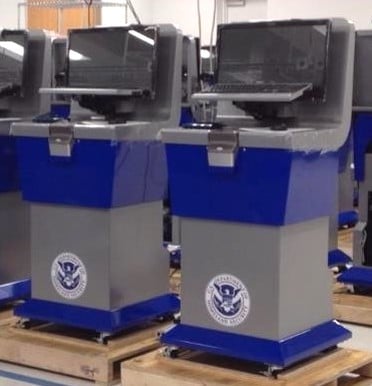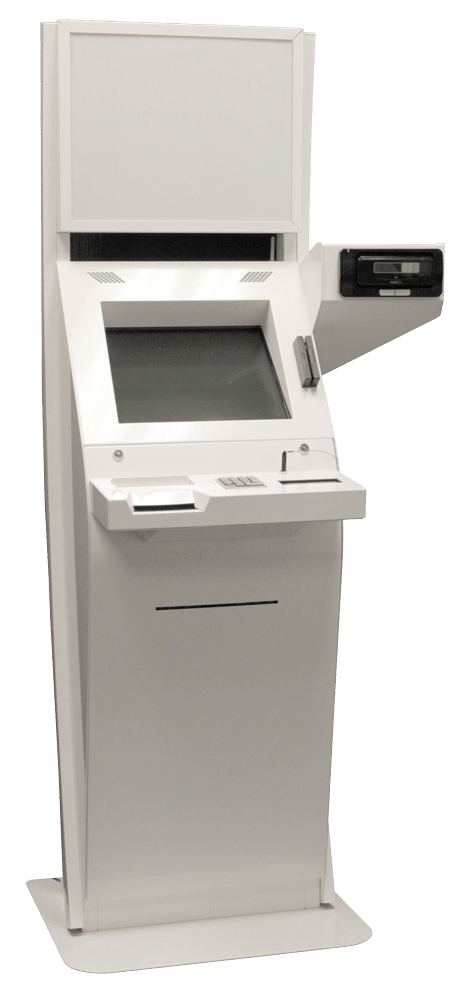Businesses are making the switch from traditional forms of security to biometric technology. Learn how to leverage biometrics through self-service kiosks.
Because of the growth in document fraud and identity theft, terrorism and cybercrime, we’re seeing an increase in the number of requests for biometric security solutions. While a biometric-based kiosk can serve several purposes, two primary uses include identity verification and advanced security functionality.
What Is Biometric Technology?
Biometric technology is a way of identifying an individual through unique characteristics including physiological or behavioral patterns. Various Biometric technologies offer enhanced security levels by confirming that the authorized individual is physically present for processing to gain access.
Security is currently a major concern everywhere in the world, especially as new emerging fraudulent threats grow even more complex. Common concerns regarding those threats are access cards, employees’ identity cards, password protection, personal identification numbers (PINs), passports, all of which often can be forgotten, lost, disclosed, or changed. Once a concept unique to science fiction, biometrics has taken a prominent position in daily life during the past decade. It has evolved to the point that it’s rare to go through a day without interacting with some type of biometric technology—from checking out the weather to unlocking your phone.
Biometric technology uses something that is a part of the user—rather than a PIN or password—to grant quick and secure access, whether to an online service or a physical building.
For example, when your smartphone or online banking app uses Touch ID or facial recognition to give you access, you’ve encountered biometric technology. According to biometrics researchers, characteristics like ear shape, how a person walks or sits, veins in the hand, and even body odor can contribute to biometrics.

Systems implementing biometric technology follow three basic steps:
- Record physical or behavioral characteristics combined with the individual’s name or identification number.
- Store the selected data after converting them into a line of code or graph.
- At the moment of log-in, the system compares the characteristics to existing records to either deny or grant access.
What Are the Different Types of Biometrics?
There are two types of biometrics:
Physiological Measurements
- Morphological identifiers—for example, fingerprints, hand shape, finger, vein pattern, eye (iris and retina) and facial shape
- Biological identifiers—including DNA, blood, saliva, or urine
Behavioral Measurements
- Voice recognition
- Signature dynamics (pressure exerted, speed of pen, inclination)
- Keystroke dynamics
- The way we use objects
- Gait
- Gestures
Physiological measurements are generally more stable throughout the life of an individual and therefore have greater benefit. Those measurements that are subject to stress, like behaviors, are more likely to deliver less reliable results.
Why Biometrics are Used
Biometric systems are useful wherever identification and authentication are critical.
The most typical uses of biometric technology include the following:
- Personal Identification (citizen, resident, voter identification)
- Border, Travel, Migration Control (passenger identification)
- Healthcare and Subsidies (patient identification)
- Physical and Logical Access (employee, contractor identification)
- Law Enforcement (criminal suspect identification)
- Commercial Use (customer identification)
Business Applications Using Biometrics Technology and Self-Service Kiosks
Even with all the traditional solutions available today, security and access control continue to challenge businesses from all industries. Utilizing cutting-edge biometric technology has shown to be an effective way to ensure a higher level of access control. Because biometrics are very difficult, if not impossible, to replicate, using a self-service kiosk that implements biometric technology can significantly enhance security while offering convenience to users.
Here are some ways businesses are using biometrics through self-service kiosks and other applications:
Airport Security and Border Control
Airports and borders worldwide have been using biometrics for years to grant access. Fingerprints have been used for several years to verify passengers’ identities. However, more recently, some travelers have had an opportunity to use facial recognition technology to experience a faster, contactless check-in process at self-service kiosks. CLEAR, a well-known identity verification service seen in major airports, has deployed these custom self-service kiosks equipped with biometric devices to provide a touchless airport experience. These one-of-a-kind kiosks are manufactured by Olea Kiosks.
In addition, Delta Airlines recently launched the U.S.’s first biometric terminal at Hartsfield-Jackson Atlanta International Airport. Delta and its partner airlines deployed rapid, real-time passenger screening using facial recognition biometrics. After the identity verification at the self-service kiosk, travelers can drop bags at the check-in counters and proceed to the TSA checkpoints.

Banking
To deliver a more seamless experience for customers, banks are beginning to leverage facial recognition biometrics for ATMs. The technology provides an additional layer of security, using facial feature identification to authenticate that the card owner is indeed the person using the card at the ATM. As more customers are concerned about identity theft, financial institutions are implementing biometric technology to combat fraud, boost security during transactions, and deliver more convenience.
Also Read: Considerations When It Comes to Bill Payment Kiosks
Building Access
From the workplace to the home, biometric technology enables superior access control. Unlike biometric identifiers in facial and iris scanning, access cards, keys, and PINs can be lost or stolen. By leveraging biometric technology, building owners can achieve greater security while giving users a frictionless entry experience.
Healthcare
As patient misidentification has been a persistent challenge for healthcare facilities, biometric technology has emerged as a reliable method of identification that is convenient for the patient. There is no need to carry a physical identification card when biometrics can reveal all the information necessary to identify patients accurately. In addition, using biometric technology with self-service kiosks in clinics and other facilities can expedite check-ins and ensure safety and security throughout the patient experience.
Smart Ticketing
Biometric technology has the potential to replace tickets for events, public transportation, autonomous cars, and more. Businesses like public transport systems and stadiums are integrating biometrics through smart ticketing and smart ID cards because it is easier for users and provides more accurate identification. It also solves the problems of ticket fraud and theft. With biometrics, ticketing becomes automatic, increasing efficiency and eliminating long lines. The “ticket” is always with the person, so they can’t lose it—it’s part of who they are.
What’s the Future of Biometrics?
Biometric kiosks can help speed and secure a wide range of identification and ID control applications, in public agencies and private businesses alike. Beyond the additional use of biometrics for identification by law enforcement agencies, and for building access and security, the future will probably see biometric kiosks offer more secure commercial transactions based on identifying users at the point-of-sale. As technologies continue to advance, it seems likely that more biometric identification measures will soon be included in all interface hardware and applications in daily commerce.
Because we’re constantly looking for ways to enhance the user experience, we will need to continue to leverage biometrics through self-service kiosks to enhance security and access control. Eliminating security threats and breaches will help businesses protect customers and increase safety and security throughout the customer experience.
Olea has extensive experience incorporating various types of biometrics tools into self-service kiosks and would be happy to help. If you’d like to discuss a self-service application using biometrics, contact us now.

